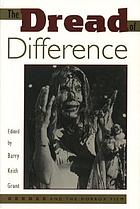


- #Barbara creed the monstrous feminine citation pdf
- #Barbara creed the monstrous feminine citation series
Norman Bates, Psycho All human societies have a conception of the monstrous-feminine, of what it is about woman that is shocking, terrifying, horrific, abject. Very rarely do exorcism films present empowered women and feminine sexuality as non-threatening. Even more recent films, produced after the emergence of third wave feminism, typically reflect this concern about women.
#Barbara creed the monstrous feminine citation pdf
If the Philippine archipelago and island continent of Australia are intersecting cultural contexts for their art, the artists’ queering of identity in art and life emphasizes a range of cultural orientations informing subjectivities, always under negotiation and transformation, and at once both the product of and in excess of these (island) territories. In The Monstrous-Feminine Barbara Creed challenges this patriarchal view by arguing that the prototype of all definitions of the monstrous is the female reproductive body. Horror and the 5 monstrous-feminine An imaginary abjection BARBARA CREED I Mother’s not herself today. File Type PDF The Monstrous Feminine Film Feminism Psychoanalysis Barbara Creed pose a threat to those around them. The notion of the monstrous feminine, as coined by feminist theorist Barbara Creed in her book The Monstrous-Feminine : Film, Feminism, Psychoanalysis, explores the importance of gender in the construct of woman’s monstrosity. However, their aesthetic interests in inhabiting fictional spaces marked by the “fantastic” and the “monstrous”-alongside the lived reality of their critical queer positions and life politics-complicate any straightforward identification. Clover, Men, Women and Chainsaws: Gender in the Modern Horror Film Barbara Creed, The Monstrous-Feminine: Film, Feminism and Psychoana We use cookies to enhance your experience on our website.By continuing to use our website, you are agreeing to our use of cookies. In the 1970s, French feminists approached feminism with the concept of criture fminine, which translates as feminine. Despite an overtly feminist reading of the horror genre offered by Creed, her analyses are based solely upon the assumption. Centring on the male spectator, Creed has written about the effects of horror as well as symbolic representations of monstrosity in film. The artists’ shared Filipino ancestry, attachments to the Filipino diasporic community, and investigations into “Philippine-ness” offer obvious cultural connections to the “Asia Pacific” concerns of the apt. This special issue on The Monstrous Global: The Effects of Globalization on Cultures explores representations of the monstrous effects and products of globalization. Barbara Creed’s 2 key theory of the monstrous feminine offers such an analysis.
#Barbara creed the monstrous feminine citation series
For the 8th Asia Pacific Triennial of Contemporary Art ( apt) (2015–16), Sydney-based artists Justin Shoulder and Bhenji Ra collaborated to present Ex Nilalang, a series of filmic and live portraits exploring Philippine mythology and marginalized identities.


 0 kommentar(er)
0 kommentar(er)
